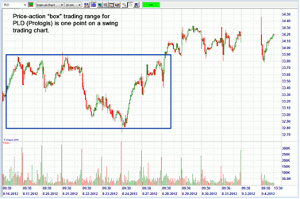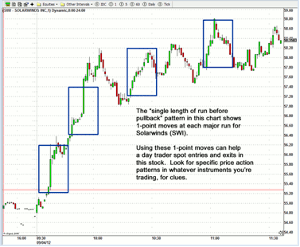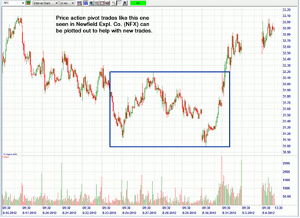One of the challenging aspects to active trading is the information overload that many traders face, by using overly complicated technical indicators, says professional trader, Ken Calhoun of TradeMastery.com and DaytradingUniversity.com.
In this three-part series of articles we’ll focus on how to use simpler price action moves (along with basic technical indicators like volume), to identify potential trading opportunities in an easy-to-follow, straightforward manner. Many top professional traders also rely primarily on price action to help identify entries and exits.
Price Action Patterns To Look For When Entering a Trade
One of the first major patterns to identify is multi-day major high-low ranges in the stocks being traded. In Figure 1, [Prologic, Inc. (PLD)], it’s evident that the trading range is just over 1.0 point (from 32.8 to 32.9). This major range is the first piece of information to use when developing a trading plan for each new entry.
For example, if a trader now enters a trade at 34.5, we use this 1-point range to develop a price target (34.5 + 1 point = 35.5). Looking for the depth of major cup patterns as seen in this chart is also helpful. In this example, the left side of the cup occurs on August 21 up at 33.8, with the right side of the cup completing on August 28, at 33.8. When looking for a new trade, the astute active trader now has a “price action move”, defined by the price elasticity as seen in this chart.
Identifying the 3- to 5- day high-low “box range” is a key price action pattern to look for when developing decisions for swing trades. Using these ranges can help with decisions related to when to wait, when to enter, and where to exit a trade once it’s taken.
Price Action Moves for Intraday Trades
Identifying the “length of single price action moves” before retracements, is one of the most important price action moves to scan for when identifying intraday trading opportunities. Looking at Figure 2 [Solarwinds, Inc. (SWI)], it’s evident that it moves in price action increments of 1 point before price action slows down or reverses.
NEXT PAGE: Price Pattern Pivots Work
|pagebreak|The key to using this approach is what we call “pattern day trading”, which is simply looking for repeating price action patterns. Day traders capitalize on this knowledge by using price elasticity to set up entries and exits on subsequent trading days.
For example if SWI opens on a following day at 59.3, a trader would anticipate trading within the 59.3 to 60.3 one-point move that would be the day trading breakout setup for this stock. Looking for these one-point moves helps day traders tighten in trailing stops for open trades before price action drops back down after a winning breakout trade is entered.
Price Pattern Pivots: How They Work
Compared to breakout trading, trading price action pivots can be more challenging. One pattern to look for here is a multi-day reversal in price following a multi-day selloff in price. In Figure 3 [Newfield Exploration Co. (NFX)], the pivot region is marked out by the box, from 31 to 32.2, as it consolidated and then started to get new buyers, for a breakout above the 32.2 area.
A common error that traders make is in getting in too early to what they think will be a successful pivot trade, only to see it go against them shortly after entering the position. Using pivot price action patterns correctly relies upon traders being more careful, as seen in this chart. The pivot entry signal wasn’t generated until a new 3-day high was seen in the chart. Looking for pivot swing trading entries with 3-day new highs can potentially be an effective trading strategy, when trading volatile stocks.
In our next article tomorrow, we’ll look at additional price-action based trading strategies. These first few are good ones to get started with, to look for in your charts as you try and identify which trades make sense to take, based on strong price action moves.
Ken Calhoun is a trading professional who has traded millions of dollars of equities since the 1990s, and is the producer of multiple award-winning trading courses and video-based training systems for active traders. He is a UCLA alumnus and is the founder of TradeMastery.com andDaytradingUniversity.com, popular online educational sites for active traders.













